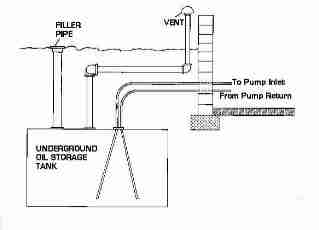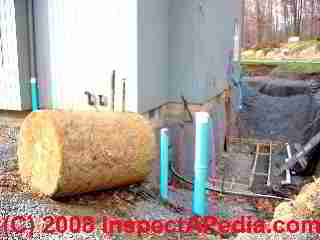 How to Use Site History or Home Heating Equipment Records to Find Evidence of Underground Oil Tanks
How to Use Site History or Home Heating Equipment Records to Find Evidence of Underground Oil Tanks
- POST a QUESTION or COMMENT about how to interpret site history and age as clues that can suggest the presence of a buried or abandoned oil storage tank at a property
Building & site history can give evidence of a buried or abandoned oil storage tank:
This is guide to finding buried oil storage tanks by using site records, oil company delivery notes, as well as visual inspection. This article assists property buyers, owners, and inspectors in the location of buried oil tanks or the detection of evidence that an underground (or even an above ground) oil tank is or was in use at a property.
Here are investigation methods that any home buyer, owner, or home inspector can apply to reduce these risks by looking for evidence that a buried oil tank is or was at a property.
InspectAPedia tolerates no conflicts of interest. We have no relationship with advertisers, products, or services discussed at this website.
- Daniel Friedman, Publisher/Editor/Author - See WHO ARE WE?
Oil Tank Site History Reivew can help determine if buried oil tanks are or have been at a property
 Buried Tanks: Look at the property before deciding to hire a tank testing company for professional inspection and testing. You can
obtain basic information such as the age (property and tank), tank location, and type of oil tank.
Buried Tanks: Look at the property before deciding to hire a tank testing company for professional inspection and testing. You can
obtain basic information such as the age (property and tank), tank location, and type of oil tank.
From a previous use, a buried oil tank may be present or may have been present at a property even if it is now served by an indoor, above ground oil tank or even by LP or natural gas. So don't assume that because you don't see a tank that none was ever used or present at a property. Make a visual site inspection for clues suggesting that one or more tanks is or was present.
Even an alert home buyer or home inspector, not charged with an environmental site survey (nor paid for one) might discover evidence of very costly buried tank problems at a property, simply by attending certain visual details and thinking about what they mean.
For the case of buried oil tanks, the next few photographs show two cases of the discovery of a nearly-hidden outside oil tank fill pipe which led to the discovery of buried oil tanks. These tanks had not been properly abandoned, risking significant cost to the property owner or buyer.
Also see Above Ground Oil Tanks: Visual Inspection.
REVIEW OIL TANK HISTORY - Oil Storage Tank History and Tips Assess the Leak Risk
 How old is the present oil tank? Tanks approaching 15 to 20 years old have a much greater risk of
leaks.
How old is the present oil tank? Tanks approaching 15 to 20 years old have a much greater risk of
leaks.
If there is no oil tank at the property now, has the heating fuel been converted from oil to gas?
Do oil companies in the area have records of having delivered oil to the property?
If so, the quantity delivered and tank size information will be on file as well as notes about the tank filler pipe location. If the oil company was hired to remove or abandon the oil tank they should have that data as well.
See OIL TANK SIZES & VOLUMES for help determining the capacity, size or volume of an oil tank.
How old is the property? A property more than 30 years old might have had two or more generations of oil tanks at the site. Sometimes local oil delivery companies will check their records of deliveries to a property and can tell you if there were other tanks at other locations at the site.
How many property owners have there been? More owners means a greater chance that a tank was removed or abandoned without the current owners's knowing about it.
If there is currently an oil tank installed, has the tank been kept relatively full in spring and fall? The extra weight helps prevent tank shifting and related piping leaks, and will reduce water in the fuel (can cause loss of heat) from condensation. Again, delivery records can inform this answer, as can testing the tank for water.
Note: these tips are not an oil storage tank installation guide. Proper installation must be done by trained service technicians and must comply with local building codes.
In the author's view (DJF), oil tank testing services and professional environmental inspectors are expected to include both a visual screen of the property for clues such as these, and also a combination of other methods to detect buried oil tanks. Some of these include
- Historical information about the site is collected.
- Oil company records may be checked for indications of deliveries or of prior tank service or removal
- Ground scanning radar may be employed to locate large buried metal objects
- Common sense observation of details, such as the location and placement of oil tank fill and vent piping, if present, can indicate the probable size and type of tanks in some cases.
- Building interior inspection for abandoned oil piping or fuel lines, or patch-marks on foundation walls where such lines may have been removed.
- An examination of the history of the property's heating systems - what equipment has been present, removed, changed.
Question:
(Apr 3, 2014) Anonymous said:
I've been told that before 1940 residential oil tanks were mostly underground and for whatever reason at the start of World War II tanks were then put above ground....is this true and why
(Nov 21, 2014) Anonymous said:
Looking to find if a specific for sale home--has or ever had a buried oil tank? If it was removed or left in ground? Evidence that a oil tank existed, but after disconnected from home--what? Where do I look/start for info?
Reply:
Anon, in addition to the article above, at the end of the article you will see article links for steps in surveying a site for evidence that it has or had a buried oil tank.
...
Continue reading at BURIED OIL TANKS, INDOOR CLUES or select a topic from the closely-related articles below, or see the complete ARTICLE INDEX.
Or see these
Buried Oil Tank Location Articles
Suggested citation for this web page
OIL TANK HISTORY REVIEW at InspectApedia.com - online encyclopedia of building & environmental inspection, testing, diagnosis, repair, & problem prevention advice.
Or see this
INDEX to RELATED ARTICLES: ARTICLE INDEX to HEATING OIL, OIL BURNERS, OIL FIRED HEATERS, OIL TANKS
Or use the SEARCH BOX found below to Ask a Question or Search InspectApedia
Ask a Question or Search InspectApedia
Try the search box just below, or if you prefer, post a question or comment in the Comments box below and we will respond promptly.
Search the InspectApedia website
Note: appearance of your Comment below may be delayed: if your comment contains an image, photograph, web link, or text that looks to the software as if it might be a web link, your posting will appear after it has been approved by a moderator. Apologies for the delay.
Only one image can be added per comment but you can post as many comments, and therefore images, as you like.
You will not receive a notification when a response to your question has been posted.
Please bookmark this page to make it easy for you to check back for our response.
IF above you see "Comment Form is loading comments..." then COMMENT BOX - countable.ca / bawkbox.com IS NOT WORKING.
In any case you are welcome to send an email directly to us at InspectApedia.com at editor@inspectApedia.com
We'll reply to you directly. Please help us help you by noting, in your email, the URL of the InspectApedia page where you wanted to comment.
Citations & References
In addition to any citations in the article above, a full list is available on request.
- [1] Fuel Storage] Tank Corrosion Study, U.S. EPA report on gasoline and oil tank corrosion, James H. Pim, P.E., John M. Searing, Suffolk County DOHS, 15 Horseblock Place, Farmingville Long Island, NY 11728, November 1988, for the Office of Underground Storage Tanks, U.S. EPA. ATTN: David O'Brien. The report presents a study of 500 underground storage tanks spanning 24 February 1987 and September 1 1988 and summarizes earlier reports on this same study. Tank sizes ranged from 175 gallons to 50,000 gallons, and oil tank ages ranged from two years to 70 years old. All 500 oil storage tanks were constructed of welded steel, and 12 other tanks that were other than plain steel were also examined. Summary [with minor edits for clarity by DJF]
- [4] Fuel Oil and Oil Heat Magazine, August 1985 p.18. Fuel Oil & Oil Heating Magazine, 3621 Hill Rd., Parsippany, NJ 07054, 973-331-9545
- [5] Standards of the National Board of Fire Underwriters, as referenced by "Domestic and Commercial Oil Burners,", Charles H. Burkhardt, 1961, 3rd Ed., McGraw Hill Book Company, p. 172
- [7] "The Interim Prohibition Guidance for Design and Installation of Underground Oil Storage Tanks", U.S. EPA, EPA/530-SW-85203, Office of Underground Storage Tanks, Washington D.C.
- [9] US EPA "How do you Properly Close a UST?" is summarized at epa.gov/OUST/fsprevnt.htm These OIL TANK CLOSURE DETAILS for temporary and permanent closing of underground oil storage tanks are provided by the US EPA as well.
- [10] "How do you choose the right tank testing method?", Cynthia Johnson, Fuel Oil & Oil Heat Magazine, November 1995
- [11] National Association of Oil Heat Service Managers, PO Box 380, Elmwood Park, NJ 07407
- [12] "Homeowners Guide to Fuel Storage," Agway Energy Products, Verbank, NY, November 1990
- [13] "Causes of Underground Corrosion", Harco Corporation, Paper HC-36, Median OH
- Our recommended books about building & mechanical systems design, inspection, problem diagnosis, and repair, and about indoor environment and IAQ testing, diagnosis, and cleanup are at the InspectAPedia Bookstore. Also see our Book Reviews - InspectAPedia.
- In addition to citations & references found in this article, see the research citations given at the end of the related articles found at our suggested
CONTINUE READING or RECOMMENDED ARTICLES.
- Carson, Dunlop & Associates Ltd., 120 Carlton Street Suite 407, Toronto ON M5A 4K2. Tel: (416) 964-9415 1-800-268-7070 Email: info@carsondunlop.com. Alan Carson is a past president of ASHI, the American Society of Home Inspectors.
Thanks to Alan Carson and Bob Dunlop, for permission for InspectAPedia to use text excerpts from The HOME REFERENCE BOOK - the Encyclopedia of Homes and to use illustrations from The ILLUSTRATED HOME .
Carson Dunlop Associates provides extensive home inspection education and report writing material. In gratitude we provide links to tsome Carson Dunlop Associates products and services.

